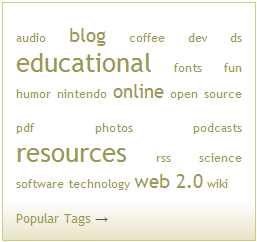
Here’s an interesting report from PEW on tagging. In Decemeber of last year they found that 28% of Internet users are taggers and 7% of us tag on a daily basis. If you are familiar with del.icio.us, you are probably familiar with the tagging phenomenon. Wikipedia calls a tag a keyword that is associated with some piece of information. If I were reading an article about the Hubble Telescope, I might tag it with astronomy. Later I could come back to my list and ask to see all the references tagged with astronomy and more easily find that one link I was looking for. Using a service like del.icio.us, you can organize all your Internet links using tags and all the links will be stored in one online location. I do this with my presentations. To find all of the links referenced in the talk I gave at the 2006 eTech Ohio Conference, you can search del.icio.us for eTechOhio06 and find all 41 of the links that were in my presentation. Having the ability to find all those links with one keyword is handy given the fact that I talked about those 41 links in a 50 minute presentation with a lot of other content. I wanted the audience to listen to the content and not worry about writing down every link. In the first minute, they all had the tag. After that, they were able to pay attention to the more important content of the presentation.
I’m a daily tagger. I blogged about Scuttle before. I setup my own server and use it for my personal bookmarks. I find it quicker to use than delicious because all the links there are mine. For class projects I have also found Scuttle to be more useful. The first time I worked with a class of 30 freshmen to build a group of links for a course, we decided to tag all the links with EDUC260 (the course number). Some people used EDUC 260 (note the space), so delicious didn’t associate those links with our “class tag”. Other students left the class tag out altogether. In the end, almost half of the links didn’t have the needed tag to associate them with the course. With Scuttle, I can create a separate “link database” for each class. It takes me an extra five minutes to setup. Considering the benefit, that is trivial. I have the students enter the links by going to a specific URL and all the links are grouped into one database without using any special tags. This way, the students may use tags that describe the content of the link and not just the course.
By using tags to keep track of information, a new visual depiction of information has been created. This is the tag cloud. The tag cloud shows a list of the tags most used in a subset. A larger font is used for the tags used most often and a smaller font for tags used the least often. The graphic at the top of this post is the tag cloud generated from all my personal links. The subset of tags can be anything: my delicious account, all delicious accounts, all tags created today, etc.
There are even tag clouds for information outside of tagged metadata. Here is an article that shows the three keynote addresses given by Steve Jobs, Bill Gates and Michael Dell at MacWorld 2007 and CES 2007. All the words from the speeches were analyzed to produce tag clouds showing which words were used the most during the talks.
Jobs: phone, iphone, ipod
Gates: devices, great, windows
Dell: gaming, great, online, digital
It will be interesting to see how analysts use tag cloud information to track different trends. Tagging certainly isn’t going to slow down.

Pingback: Taste of Tech » Summer Renewal 4: Mmmm, Del.icio.us
Pingback: Alvin’s Educational Technology Blog » Efficiency Tip #87 - Del.icio.us
Pingback: Alvin’s Educational Technology Blog » Check your blog's reading level